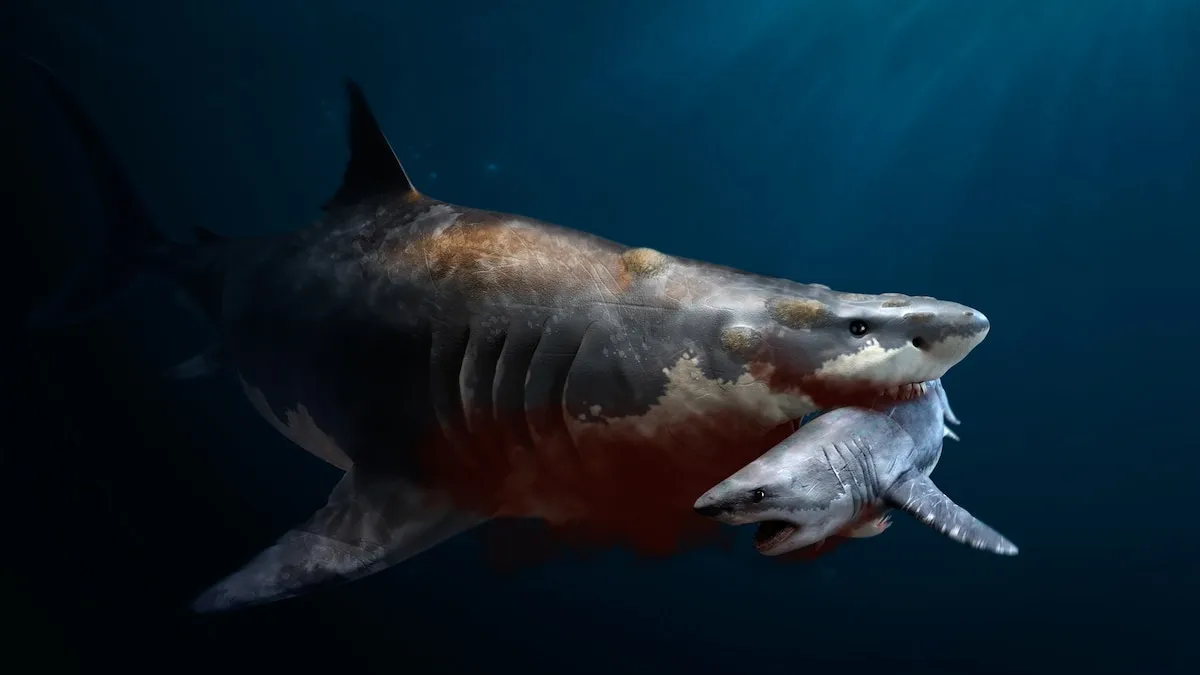
Close your eyes and imagine the ancient, abominable megalodon. You’re likely picturing a great white shark scaled up to gargantuan proportions, right? However, a new study suggests that the world’s largest-ever shark may have been even longer and more svelte than previously believed. “Prior studies simply assumed that megalodon must have resembled a gigantic version of the modern great white shark without any substantial evidence,” says Kenshu Shimada, a vertebrate paleontologist at DePaul University in Chicago.
Both the great white shark and megalodon (Otodus megalodon) boast prominent serrations on their teeth, akin to a steak knife. This similarity led scientists to initially believe that great whites (Carcharodon carcharias) were direct descendants of the megalodon, as depicted in popular media. Yet, recent research indicates that megalodon belonged to a different branch of the shark family tree. The enduring comparison to great whites lingered largely due to a lack of better alternatives, according to Shimada.
In a groundbreaking study published in the journal Palaeontologia Electronica, Shimada and over two dozen experts propose that megalodon likely had a much less stocky body plan than the barrel-chested great whites. They also presented a new estimate for megalodon’s total length, suggesting that it could have stretched up to an astounding 80 feet (24.3 meters). This is significantly larger than previous estimates, which capped the meg at around 50 feet (15 meters), meaning the largest megalodons could rival the size of a blue whale.
“Our new value represents the most reasonable maximum possible estimated total length for megalodon based on the current fossil record and data,” states Shimada.
For many ancient creatures, scientists possess entire skeletons that allow for accurate reconstructions of their appearance in life. However, studying the megalodon presents a unique challenge. The fossil record primarily consists of vertebrae, teeth, scales, and fragments of cartilage. Some paleontologists have relied on the teeth or vertebral columns of great whites to hypothesize the dimensions of this ancient shark. Yet, critical parts of megalodon, including the head, tail, and fins, remain elusive. If you’ve ever posed for a photo in front of a megalodon jaw at a museum, you may have been standing in front of a mere educated guess, as no actual jaw of the meg has ever been found.
To bridge the gaps in knowledge, Shimada and his team developed a novel method to estimate the body length of this leviathan. They utilized a nearly complete vertebral column from Belgium, along with an incomplete vertebral column from Denmark. By comparing these findings to the body plans of 170 other shark species, both existing and extinct, they estimated the likely dimensions of the megalodon’s head and tail—around six feet (1.8 meters) and 12 feet (3.6 meters), respectively. This analysis suggests that the Belgian megalodon specimen measured 54 feet (16.4 meters) long. However, due to the larger size of one vertebra from the Danish find, the researchers scaled up their estimates, arriving at the remarkable new total length.
The scientists also aimed to determine megalodon’s “fineness ratio,” a measurement that indicates how slender a body or object is. “In simplest terms, a fineness ratio evaluates the slenderness of a body,” explains Shimada. They referenced measurements from both living and extinct shark species. The largest current sharks, such as the whale shark and basking shark, possess slimmer body forms, which enhance their hydrodynamic efficiency in ocean waters. If the body plan of a great white were scaled up to megalodon-like lengths, it would encounter significant swimming challenges.
“Although we still require direct fossil evidence, our new study suggests that megalodon was likely more slender than the modern great white shark from a hydrodynamic perspective,” Shimada asserts.
Jack Cooper, a palaeobiologist from Swansea University in Wales, commended the authors for their innovative body size estimate and for avoiding reliance on a single analog, like the great white. However, he cautioned that the support for a slender body form remains tentative. The researchers also conducted hydrodynamic analyses based on the new body shape, indicating that even at full size, megalodon would not have been faster than modern-day great whites. Additionally, by examining growth bands within vertebrae, they estimate that newborn megalodons measured around 12 to 13 feet long at birth, potentially making them the largest fish offspring ever.
This rapid growth in young megalodons could have been a strategy to avoid predation by great whites. Such insights are crucial, as many scientists believe competition with great whites contributed to the eventual extinction of the megalodon. While Cooper found the notion of massive babies intriguing, he noted that the theory regarding young megalodons growing faster to outpace predators is highly speculative.
In recent years, public interest in megalodon research has surged. Both Shimada and Cooper agree that focusing solely on maximum size and hypothetical confrontations, like whether megalodon could defeat the extinct whale Livyatan in battle, distracts from the incredible biology learned about this iconic species. Recent studies, including one co-authored by Shimada, provide geochemical evidence suggesting that megalodon may have been at least partially warm-blooded. This adaptation could have enabled the predator to pursue prey, such as whales, into colder waters, facilitating its massive size.
With limited fossil evidence available, it remains possible that megalodon looked entirely different from current estimates. “This possibility cannot be ruled out until well-preserved, complete skeletons are discovered,” Shimada concludes. Until then, researchers are constrained by existing data, but the journey of discovery continues to unveil the mysteries surrounding this legendary creature.